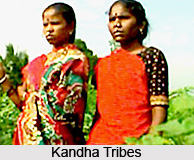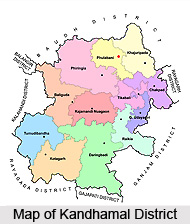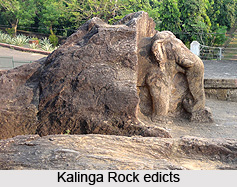 Kandhamal District is one of the administrative districts of Orissa with its headquarters at Phulbani. Kandhamal District lies between 19 degree 34 minutes and 20 degree 50 minutes north latitude and in between 80 degrees 30 minutes and 84 degrees 48 minutes east longitude. It is bounded by Boudh district in the north, by Rayagada district in the south, by Ganjam District and Nayagarh district in the east and by Kalahandi district in the west. Total geographical area covered by Kandhamal District is 7654 sq kms that accounts for around 7.14 percent of the total area of the state. Kandhamal District was formed on 1st of January, 1994. Over all, Kandhamal District is ranked as a backward district of Orissa.
Kandhamal District is one of the administrative districts of Orissa with its headquarters at Phulbani. Kandhamal District lies between 19 degree 34 minutes and 20 degree 50 minutes north latitude and in between 80 degrees 30 minutes and 84 degrees 48 minutes east longitude. It is bounded by Boudh district in the north, by Rayagada district in the south, by Ganjam District and Nayagarh district in the east and by Kalahandi district in the west. Total geographical area covered by Kandhamal District is 7654 sq kms that accounts for around 7.14 percent of the total area of the state. Kandhamal District was formed on 1st of January, 1994. Over all, Kandhamal District is ranked as a backward district of Orissa.
History of Kandhamal District
The region of Kandhamal is an abrupt hilly tract, which forms an endless series of valleys varying in size. This untamed hilly tract owes its significant importance from the past history, which dates far back to 3rd century BC, when it was considered as an unconquered Atavika country. The legendary Kalinga Rock edicts, excavated in the wide region of Kandhamal, state that the district of Kandhamal was under the Mauryas were at the helm of administration in Atavika country. The mountainous Atavika country in the later years came to be identified as Kandhamal. In the later years, following the available historical records of the Kandhamal, some historians have opined that the district is named after the vigorous Khonds, who used to dwell the land. The region of Kandhamal survived attained spotlight in the map of Orissa, during the Dakshinapatha campaign of the Gupta ruler Samudragupta in the 4th century. As the history of Kandhamal runs, Samudragupta led his victorious army to the south from Kosala and Kural through this district and defeated some kings in Ganjam. This region unquestionably encompassed the Kandhamal region, of which the Guptas had their absolute dominance for a couple of years.
However the historical documents of Kandhamal so far are revealed do not demonstrate the socio-economic and political condition of Kandhamal aftermath the Guptas. The region of Kandhamal was in complete obscurity before the arrival of the Bhanjas as the sovereign authority of Orissa. The present district of Kandhamal is made up of the fragments of the three erstwhile principalities of Boudh, Ghumsar and Khemundi, which were formed during the reign of the Gangas, the last indigenous rulers in the throne of Orissa.
 The contemporary history of the Kandhamal district is documented with the arrival of the British in the nineteenth century. As far the history of Kandhamal is concerned, the British were not successful enough to find their way out without confronting any resistance. Bhanjas occupied this state and continued to rule over it till 1835. Ganjam came under the British rule in 1765. Though in the beginning the Bhanjas did not put up any aggressive interference in the activities of the British, in the later years, the growing opposition among the two powers were noticed as the historical records pronounce. Finally they raised the banner of revolt frequently against the British. The Kandhas and the Paikas forming the Ghumusar army waged relentless wars under the able leadership of Dohara Bissoyi from 1815 to 1835.
The contemporary history of the Kandhamal district is documented with the arrival of the British in the nineteenth century. As far the history of Kandhamal is concerned, the British were not successful enough to find their way out without confronting any resistance. Bhanjas occupied this state and continued to rule over it till 1835. Ganjam came under the British rule in 1765. Though in the beginning the Bhanjas did not put up any aggressive interference in the activities of the British, in the later years, the growing opposition among the two powers were noticed as the historical records pronounce. Finally they raised the banner of revolt frequently against the British. The Kandhas and the Paikas forming the Ghumusar army waged relentless wars under the able leadership of Dohara Bissoyi from 1815 to 1835.
The history of Kandhamal depicts that the present subdivision of the Kandhamal district, Balliguda region was under the Gangas of Kandhamal and the dynasty ruled over these hilly tracts till the 19th century, till the British captured the area in 1830 to 1880, by subduing the hilly chiefs, who were the supporter of the Gangas. Kandhamal, which was originally the part of the Boudh district, experienced a chequered history during the same period. The present subdivision of the Kandhamal sub division was an integral part of Boudh till 1855. It was the British rule that fragmented the parts of Kandhamal from Boudh.
Geography of Kandhamal District
Physiographically the entire district lies with high altitude zone with inaccessible terrain of hilly ranges and narrow valley tracts which guides the socio-economic conditions of people and development of the district. Kandhamal District has two sub-divisions, Phulbani and Balliguda. Phulbani sub-division forms a broken plateau of about 518 metres above sea level. On the north-east and west these ranges quite perceptibly rise abruptly from the plains of Boudh district while on the south they merge in the outlines of the Eastern Ghats of Balliguda sub-division. The high plateau lying within these ranges is broken up by numerous smaller ranges which form an endless series of valleys varying in size. Thick forest still covers much of these tracks and the villages lie in scattered clearings along the hill sides and in valleys below, while some are in almost inaccessible places on the top most summits of the hills. This hilly tract is intersected in all directions by streams. The uplands and slopes leading down from the foot of the hills are utilised for growing dry crops periodically depending on the rain. The area of cultivated land is small. The Balliguda Sub-division is on the plateau and lies at height varying from 300 meters to 1100 meters above the mean sea level. The eastern side of the sub-division consists of wide well cultivated valleys. The small hamlets dotted throughout the district are covered with thick impenetrable forest and the winding streams and torrents intersect the hilly tract. The hills of this sub-division are a part of the Eastern Ghats. Kandhamal District has a sub tropical dry climate. Maximum temperature recorded is around 45 degree Centigrade and minimum temperature as nearly 2 degree Centigrade.
Culture of Kandhamal District
Kandhamal District is very famous for handicrafts such as Dokra, Terra-Cotta, Cane and Bamboo works.
 The region is proud of its rich cultural heritage. Mauryan Emperor Ashoka mentioned in Jaugada (Ganjam) edict about the people of this hill tract as Atavikas who practiced their own religion. The ghat tract of Kandhamal `Kalinga` was known to the travellers of medieval history. The tract was used for the transportation of salt to central India.
The region is proud of its rich cultural heritage. Mauryan Emperor Ashoka mentioned in Jaugada (Ganjam) edict about the people of this hill tract as Atavikas who practiced their own religion. The ghat tract of Kandhamal `Kalinga` was known to the travellers of medieval history. The tract was used for the transportation of salt to central India.
Tourism in Kandhamal District
The district of Kandhamal is bestowed with the beauty of nature. It has wild life, scenic beauty, healthy climate, and serpentine ghat roads for the tourists. It has attractions, like panoramic coffee gardens, pine jungles, Ghat roads, hills and water falls, virgin forest and typical tribal village life. Almost 66 percent of the land area of the district is covered with dense forests and towering mountains rich in green meadows at the attitude of 2000 feet to 3000 feet, the terraced valleys thronged with these colourful tribal in their natural heritage, dancing and sporting has its own appeal.
Nearest airport is at Bhubaneswar and nearest rail head is at Berhampur at around 165 kms from Phulbani.






